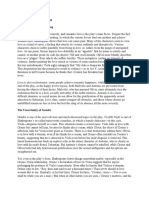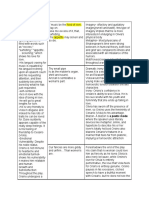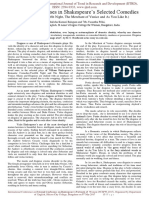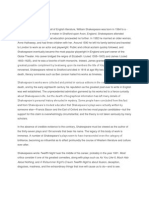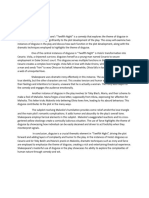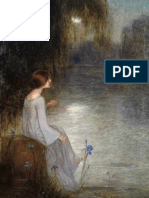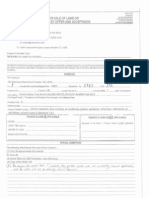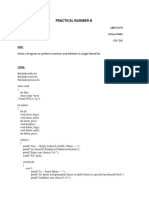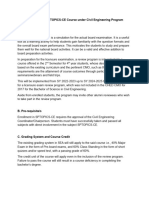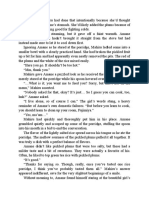0 ratings0% found this document useful (0 votes)
36 viewsEnglish Year 9 Term 2
The document provides an overview of Shakespeare's play Twelfth Night, including the writer's intent, key ideas, characters, methods, and symbols. It explores themes of gender fluidity, appearance vs reality, love as a source of suffering, and the folly of ambition. Characters like Viola/Cesario, Orsino, and Malvolio are examined in the context of these themes.
Uploaded by
Stephen EdwaardsCopyright
© © All Rights Reserved
Available Formats
Download as PDF, TXT or read online on Scribd
0 ratings0% found this document useful (0 votes)
36 viewsEnglish Year 9 Term 2
The document provides an overview of Shakespeare's play Twelfth Night, including the writer's intent, key ideas, characters, methods, and symbols. It explores themes of gender fluidity, appearance vs reality, love as a source of suffering, and the folly of ambition. Characters like Viola/Cesario, Orsino, and Malvolio are examined in the context of these themes.
Uploaded by
Stephen EdwaardsCopyright
© © All Rights Reserved
Available Formats
Download as PDF, TXT or read online on Scribd
You are on page 1/ 2
Knowledge Organiser: Twelfth Night
Writer’s Intent Key Ideas
Key Idea Definition Example
Twelfth Night is one of Shakespeare’s
Gender Fluidity Shakespeare shows how traditional views of gender as binary Whilst the main exploration of this is through Viola/ Cesario, the relative
comedies. The festival of Twelfth Night was
and fixed can be pulled into question. Instead he presents a attractions of Olivia to Cesario and Orsino to Cesario also bring into question
a holiday when everything was turned
more fluid exploration of gender and the relative powers that gender normative relationships. Furthermore, Olivia is seen to control and run her
upside down – this is an element
come with it that are more in keeping with today’s views. household with more authority than Orsino who is often depicted moping.
Shakespeare uses as a source of comedy.
Appearance and Shakespeare uses characters’ reliance on, and faith in, Appearance and reality can be seen in the tricking of Malvolio where he believes
Shakespeare plays with conventions of
reality appearance as a source of the majority of the play’s that the letter is a genuine love letter from Olivia – the appearance – when it is in
gender and moral codes to explore and
misunderstanding that lead to the comic elements. fact a ruse put together by Sir Toby and Maria.
critique the society he lives in.
Key Characters Love as a Cause of Whilst the play ends happily, like any romantic comedy (which Orsino is in a state of angst and depression throughout the play as a result of the
Suffering arguably it is), along the way love – or more precisely unrequited love that he has for Olivia. This is also reflected in Olivia’s own sadness
Orsino
unrequited love – causes pain. Many of the characters use and regrets when she falls for Cesario and this adoration is also unrequited.
The Duke of Illyria and its ruler. He is a
language that suggests they view love as a curse that attacks Though at the end of the play, the norms have been restored and Shakespeare
perfect gentleman and is used as a vehicle
its victims suddenly. does present some hope for love.
to explore the absurdity of love.
Viola/ Cesario Revenge Revenge is used by Shakespeare in the sub-plot of the play. It Malvolio and Sir Toby are caught in a cycle of revenge that eventually leads to
The heroine in the story who disguises brings a darker form of comedy to the play than that of the Malvolio’s demise and promise of future revenge. Malvolio wishes to get revenge
herself as her twin brother. Her plight is protagonists. Shakespeare shows how revenge can escalate on Sir Toby because of his excessive behaviour and humiliation of him. Whereas
the central conflict in the play. from actions that at first seem like harmless jest, to ones Sir Toby wants to get revenge on Malvolio because of his pride and persistent
Lady Olivia which are cruel and cause serious mental distress. This could criticism of their behaviour.
A rich countess who is in mourning and be seen as a critique of some sides of humanity.
uses this to stay off the advances of men – The folly of A reoccurring theme in Shakespeare’s plays, it shows how Malvolio’s character, and the treatment he receives at the hands of Sir Toby and
until she meets and falls for Cesario. ambition those who overreach their station – and so challenge the Maria, explores the foolishness of having aspirations above your station. It is of
Sir Toby Belch natural social order – are doomed to failure. This is one of the note that he is the only character in the play who does not marry or receive a
Lady Olivia’s uncle. He uses Olivia’s money ways in which Shakespeare restores, and ensures order. happy ending – he is in fact excluded from the festivities at the end.
to keep himself entertained – including
playing tricks on others. Writer’s Methods
Malvolio Method Definition Example Purpose
Lady Olivia’s steward. He has fantasies that A light-hearted play with a happy ending 1. Viola and her family are introduced. The comedic structure follows Freytag’s Pyramid of
he might marry Olivia and rise above his usually involving marriages between the 2. There’s a shipwreck and only Viola survives. Dramatic Structure. Shakespeare uses the exposition to
class. He’s a puritan so criticises excessive unmarried characters. 3. Viola disguises herself as Cesario and as position the characters in an unfamiliar or unusual
lifestyles. Shakespearea 1. Introduction of main character(s) Cesario discovers elements of her character. setting which then allows for a range of mistakes or
Feste n Comedy 2. Tragic Event 4. Viola and Sebastian meet one another and misconceptions to occur which form the basis of the
Lady Olivia’s clown. He is Shakespeare’s 3. Journey (physical / self-discovery) realise their sibling has survived. comedy. In the final act, there is a return to normal
mouthpiece, ocriticising other’s actions. 4. Reconciliation 5. Viola’s true identity is revealed, and she order which allows Shakespeare to reassert order and
5. Resolution and Happy Ending marries Orsino. control before the audience leaves.
Sir Andrew Aguecheek It creates comedy as the audience is aware of the
When the full significance of words or
A knight who is encourage by Sir Toby to When Olivia falls in love and courts Cesario, foolishness of Olivia’s actions. Shakespeare uses
Dramatic Irony actions is clear to the audience but
court Olivia. This is done so Sir Toby can but the audience know it is really Viola. dramatic irony in the play to show the cruelty or comedy
unknown to the character.
trick him out of his money. of characters’ actions.
Maria Viola/ Cesario’s soliloquies show how she is
A speech where an actor speaks their They allow the reader to create an emotional bond with
Lady Olivia’s serving woman. She is clever Soliloquy struggling to navigate the world she is in –
thoughts aloud usually when alone. Viola as they are able to see her vulnerabilities.
and works with Sir Toby to trick Malvolio. particularly in terms of love.
Sebastian
The use of objects or items to represent Clothes are seen as a symbol of the It invites the audience to question some of the social
Viola’s twin brother. He is initially mistaken Symbolism
other ideas or concepts. performative nature of gender. constructs which govern their lives.
for Cesario which leads to comic mishaps.
NOA English Department
Knowledge Organiser: Twelfth Night
Key Word Glossary
Word Definition Example Word in Action
Lines in a play that are intended to be heard by the audience Cesario’s asides give the audience an awareness
Aside
but unheard by the other characters in the play. of how her true self feels.
Characterisation The building or crafting of a fictional person. Aguecheek is characterised as a fool.
Giving an appearance or impression different from the true Sir Toby deceives Malvolio by making him think
Deception
one; misleading. Olivia wants to marry him.
Give (someone or oneself) a different appearance to conceal Viola disguises herself as a man.
Disguise
one’s identity.
Shakespeare wrote his plays when Elizabeth 1st and James Twelfth Night was an Elizabethan festival.
st
Elizabethan 1 ruled England. We refer to the time that Elizabeth was on
the throne from 1558-1603 as the Elizabethan Era.
Epiphany A moment of sudden and great revelation or realisation. Olivia has an epiphany when she meets Cesario.
The belief in full social, economic, and political equality for The positive presentation of women in the text
Feminism
women. means that it can be seen as feminist.
Melancholy A feeling of pensive sadness, typically with no obvious cause. Malvolio is a melancholic character.
Motif A dominant or recurring idea in an artistic work. Letters are a motif in the play.
Control or influence (a person or situation) cleverly or Sir Toby manipulates Aguecheek.
Manipulate
dishonestly.
A figure of speech in which apparently contradictory terms Feste often uses oxymorons to highlight the
Oxymoron
appear in conjunction. stupidity of other characters.
A system of society or government controlled by men. Olivia’s state of mourning occurs because of
Patriarchal
patriarchal traditions.
Feeling of sorrow and compassion caused by the suffering The treatment of Malvolio arouses pity in the
Pity
and misfortunes of others. audience.
A joke exploiting the different possible meanings of a word Feste often uses puns as a form of humour.
Pun or the fact that there are words which sound alike but have
different meanings.
A change to an opposite direction, position, or course of There is a reversal in Orsino’s adoration of
Reversal action. Olivia in the final act.
A poem of fourteen lines using any of a number of formal Shakespeare uses the sonnet form in the play to
Sonnet rhyme schemes. Sonnets typically have 10 syllables per line parody love.
and are traditionally love poems.
The place or type of surroundings where something is The setting of the play is Ilyria – a distant and
Setting
positioned or where or when an event takes place unknown place for Shakespeare’s audience.
Sub-plot A secondary strand of the plot that is a supporting side story. Sir Toby and Malvolio’s sparring is a sub-plot.
NOA English Department
You might also like
- Two Devices Used by Shakespeare in Twelfth Night - Read For ExamsNo ratings yetTwo Devices Used by Shakespeare in Twelfth Night - Read For Exams8 pages
- Study Questions and Topics For Twelfth NightNo ratings yetStudy Questions and Topics For Twelfth Night2 pages
- Acad 2022-2023 - Level M - Quotation and Comment Table - Term 2 Week 8 Lesson 2 Monday 30-01-23No ratings yetAcad 2022-2023 - Level M - Quotation and Comment Table - Term 2 Week 8 Lesson 2 Monday 30-01-236 pages
- William Shakespeare's Play _ Twelfth Night _ as a Romantic Comedy (1)No ratings yetWilliam Shakespeare's Play _ Twelfth Night _ as a Romantic Comedy (1)3 pages
- Masks and Disguises in Shakespeare S Selected ComediesNo ratings yetMasks and Disguises in Shakespeare S Selected Comedies2 pages
- STRUCTURE of The Play (Plot and Subplot)No ratings yetSTRUCTURE of The Play (Plot and Subplot)3 pages
- Twelfth Night summary, analysis, characters, themesNo ratings yetTwelfth Night summary, analysis, characters, themes3 pages
- Twelfth Night - Spark Notes & Cumming GuideNo ratings yetTwelfth Night - Spark Notes & Cumming Guide23 pages
- In Situ:: Twelfth Night King Lear The Winter's Tale MacbethNo ratings yetIn Situ:: Twelfth Night King Lear The Winter's Tale Macbeth16 pages
- Dog Cake Recipe For Dozer's Birthday! RecipeTin EatsNo ratings yetDog Cake Recipe For Dozer's Birthday! RecipeTin Eats26 pages
- TOR ASEAN CSOs Virtual Consultative Sessions On AAFDM - Pujiono CentreNo ratings yetTOR ASEAN CSOs Virtual Consultative Sessions On AAFDM - Pujiono Centre6 pages
- Ikigai - A Reflection On Life - Cult of Tarot ForumNo ratings yetIkigai - A Reflection On Life - Cult of Tarot Forum3 pages
- Practical Number-8: Write A Program To Perform Insertion and Deletion in Single Linked ListNo ratings yetPractical Number-8: Write A Program To Perform Insertion and Deletion in Single Linked List7 pages
- Gerunds and Infinitives Through Poem PDFNo ratings yetGerunds and Infinitives Through Poem PDF5 pages
- The Angel Next Door Spoils Me Rotten v01 (Yen Press) (LuCaZ) - 5No ratings yetThe Angel Next Door Spoils Me Rotten v01 (Yen Press) (LuCaZ) - 58 pages
- DISS-LESSON-PLAN-1-.sir Jan Mark - Docx1No ratings yetDISS-LESSON-PLAN-1-.sir Jan Mark - Docx15 pages
- Job Advertising Project Assistant Reporting To: Contract Duration: Contract Type: Expect Start Date: Duty StateNo ratings yetJob Advertising Project Assistant Reporting To: Contract Duration: Contract Type: Expect Start Date: Duty State2 pages
- Important Topic Wise Current Affairs - April 2024-Important Awards & Honours NewsNo ratings yetImportant Topic Wise Current Affairs - April 2024-Important Awards & Honours News6 pages
- Low Zafin Jiki Nukiliya Makamashi: Sanyi Fusion, Kyauta Ikon Karya Kimiyya? (Taƙaitaccen A Harshen Hausa) / Cold Fusion: Free Energy Pseudo Science?No ratings yetLow Zafin Jiki Nukiliya Makamashi: Sanyi Fusion, Kyauta Ikon Karya Kimiyya? (Taƙaitaccen A Harshen Hausa) / Cold Fusion: Free Energy Pseudo Science?498 pages
- ENENDA1L - Engineering Data Analysis-LabNo ratings yetENENDA1L - Engineering Data Analysis-Lab7 pages
- File - 20211027 - 154730 - GCS200060 - Tran Lam Bao Tran - Assignment2No ratings yetFile - 20211027 - 154730 - GCS200060 - Tran Lam Bao Tran - Assignment234 pages






